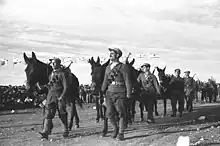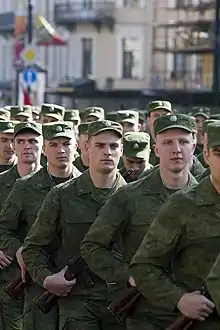
A patrol hat, also known as a field cap, is a soft kepi constructed similarly to a baseball cap, with a stiff, rounded visor but featuring a flat top, worn by military personnel of some countries in the field when a combat helmet is not required.[1]
History
U.S. Military
M1951 Field Cap and Ridgeway Cap

The M1951 Field Cap, introduced with the M1951 Uniform, was a derivative of the M1943 Field Cap, part of the M1943 Uniform.[2][1][3] The M1951 cap was worn in the Korean War, where it became known as the "patrol cap" by the US Army Rangers there.[1] It was constructed of wind-resistant olive-drab cotton poplin, and had a flannel wool panel that folded down to cover the ears and the back of the head.[1] It was soft enough to be worn underneath an M1 helmet.[1]

After the Korean War, the cap was replaced by the Ridgeway Cap, a stiffened version of the M1951 made by Falcon and known as the Jump Up cap.[1] The hat became famous outside America after being worn by Fidel Castro. The patrol cap was replaced altogether in 1962 with a baseball-like "Cap, Field (Hot Weather)"; during the Vietnam War in-country troops were issued the boonie hat.[4][5]
In 1980, the Army introduced the Battle Dress Uniform (BDU), which featured a patrol cap similar to the M1951 Field Cap, including the wool panel to cover the ears, except it was in Woodland camouflage. The BDU was replaced, starting in 2004, with the Army Combat Uniform (ACU).
Starting on June 14, 2001, Army Chief of Staff General Eric Shinseki made the black beret the standard headgear for Soldiers in the garrison environment. On June 14, 2011, the M1951/ACU soft patrol cap became once again the primary headgear for all Soldiers as the duty uniform headgear after a 10-year hiatus in favor of the beret, according to Army Directive 2001-11.[6]
Modern patrol caps
In 1981, following the introduction of the M81 Battle Dress Uniform, the patrol cap was reintroduced.[7] The patrol cap continues to be worn with the Army Combat Uniform, introduced in 2004.[8] The materials are 50% cotton, 50% nylon blend.[7] It has been available in different variants and patterns, such as hot weather models which have eliminated the ear flaps.[7]
Patterns have included US Woodland, Six color desert camouflage, Three color desert camouflage, Universal Camouflage Pattern, and Operational Camouflage Pattern.[7][8] The ACU patrol cap features a velcro-backed patch on the back with the soldier's name printed on it and a small internal pocket, the soldier's rank insignia is pinned on the front, as seen in the image below.
 Two soldiers wearing the ACU, as well as UCP-patterned patrol cap (left) and boonie hat (right).
Two soldiers wearing the ACU, as well as UCP-patterned patrol cap (left) and boonie hat (right). USAF Captain wearing Airman Battle Uniform with digital tigerstripe-patterned patrol cap
USAF Captain wearing Airman Battle Uniform with digital tigerstripe-patterned patrol cap
Israel Defense Forces

This style of military uniform cap was worn by the Muleteers' Battalion founded in January 1948 which was named for the British Army's Zion Mule Corps of the World War I, a forerunner of the Jewish Legion. The IDF adopted the "Kova Hitelmacher" [(in Yiddish): hatmaker's cap] for soldiers' uniforms in its early years.
Russian military


The Russian army adopted the patrol cap when it adopted the woodland pattern Flora camouflage in and then EMR camouflage VKBO uniforms in the early 2000's. There are two versions, a plain one worn by conscripts and a more elaborate one worn by kontrakniki and officers.
See also
- Utility cover, the U.S. Navy and Marine Corps equivalent
- Side cap
- Jeep cap